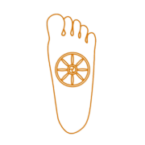 Even after all these years, many people in the Pioneer Valley know nothing about the generous and well-connected Cambodian Buddhist temple in their midst, Wat Kiry Vongsa Bopharam (www.templenews.org). This is in part because of the language barrier – it’s possible to walk the facilities or sit in during the meal or even join the yearly summer meditation retreat, but almost all functions are conducted in the Khmer language.
Even after all these years, many people in the Pioneer Valley know nothing about the generous and well-connected Cambodian Buddhist temple in their midst, Wat Kiry Vongsa Bopharam (www.templenews.org). This is in part because of the language barrier – it’s possible to walk the facilities or sit in during the meal or even join the yearly summer meditation retreat, but almost all functions are conducted in the Khmer language.
The founder of Wat Kiry was actually a very important figure in Cambodian Buddhism – Pre-ah Māhāghosananda. He was a monk who fatefully survived the genocide known as the Khmer Rouge in the 70’s by being in Thailand at the time. He returned afterwards to a devastated Sangha and broken people. He spent the rest of his life rebuilding the community and working to heal the deep trauma of his country. During that time, he became friends with other powerful Buddhist figures such as the Dalai Lama and Nichidatsu Fujī, the founder of the Nipponsan Myohoji sect of Japanese Buddhism. Māhāghosananda was known for his long, dangerous Peace Walks through Cambodia to restore faith for the people, a practice very similar to the walks performed by Ven. Fujī-san.
 When Ven. Fujī-san’s disciples began work on a massive stupa on a hill in Leverett, MA, Māhāghosananda inquired about using a piece of the land for a forest monastery. Instead he learned that the land at the base of the hill was for sale. It was purchased, but in the early years there was very little money for development. A few white-robed nuns moved on to the property and began practicing in earnest despite the rustic conditions. When one teacher saw them meditating on the hill he commented on how they looked like white flowers in bloom, and Wat Kiry Vongsa Bopharam got it’s name – the Temple of the White Flowers on the Hill.
When Ven. Fujī-san’s disciples began work on a massive stupa on a hill in Leverett, MA, Māhāghosananda inquired about using a piece of the land for a forest monastery. Instead he learned that the land at the base of the hill was for sale. It was purchased, but in the early years there was very little money for development. A few white-robed nuns moved on to the property and began practicing in earnest despite the rustic conditions. When one teacher saw them meditating on the hill he commented on how they looked like white flowers in bloom, and Wat Kiry Vongsa Bopharam got it’s name – the Temple of the White Flowers on the Hill.
Māhāghosananda visited the temple and even spent the last years of his life frequently there. It’s grown into a well-established facility now housing three monks full-time and hosting yearly meditation retreats attended by cambodians from across the country. Nevertheless, few locals realize it is a totally different order from the visually stunning Peace Pagoda up the hill.
I came to know Wat Kiry by accident, after coming to visit the Peace Pagoda. I was going back down the hill with my almsbowl out and was seen by the temple president, who ushered me into his office. The presence of a Theravada Buddhist monk on his property couldn’t be a coincidence, so he assumed I was coming to stay! Still, he and the only other resident monk, Dakun Ponh Phep, struggled to make sense of what I was. The idea of an American ordaining was almost entirely foreign to them, and yet I produced a wealth of evidence that not only was I a real monk, but that I came from a long line of western teachers (I had photos!). They gaped at the copy of the Dhammapada I carried in Pali and English text, and Ponh Phep’s eyes fogged over with long-lost memories as I chanted the monk’s rules in Pali – something very few members of the revived Cambodian sangha can do but which is still impossible (or pointless) to fake.
They regretfully informed me I couldn’t stay (to my surprise!) because I didn’t speak Khmer and they didn’t speak much English (they do, but they are shy). They have though provided me with aid and inspiration over the years, asking nothing in return. I’ve been given occasional shelter, bowls of food, the chance to perform monastic functions with the monks, and I’ve been able to join their delightful summer retreats despite the dhamma talks all being incomprehensible. If anything, I was a frustration to them, as I frequently walked away from their overflowing offerings of money, shelter, and requisites to keep up my bizarre dhutanga practice.
It was my great joy to return in 2021 to see Dakun Ponh Phep still well and joined by two younger monks who came in 2018. They’ve quietly sheltered through the pandemic. The moment I arrived they didn’t miss a beat setting me a place and grabbing some extra food. Not too much has changed. Time will tell whether this will be the year of their emerging to resume normal operations.
Visitors can come at any time. During daylight hours the meditation hall is open, but be sure to go past the temple up the walkway to a giant Parinibbana Buddha on the hill. While the Peace Pagoda up top has always been the place to go to offer prayers, do yoga, or beat some drums, when I want to meditate I prefer the calm, shady hemlock groves of Wat Kiry, resonating with the flutey calls of Woodthrushes.
